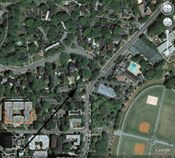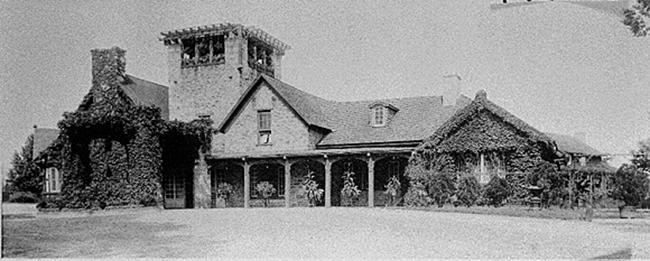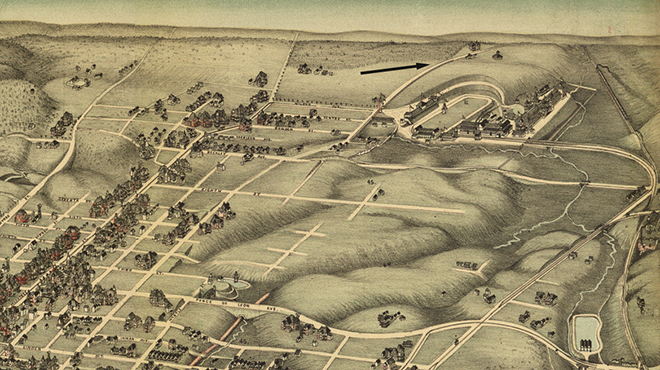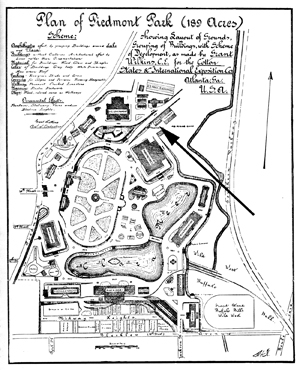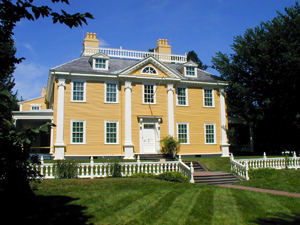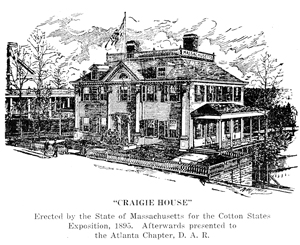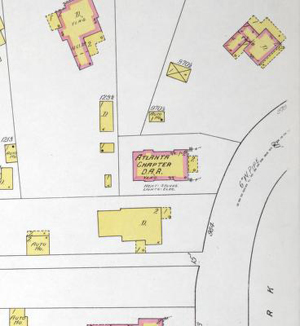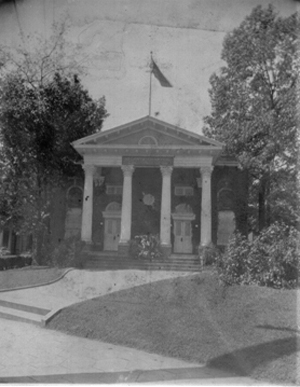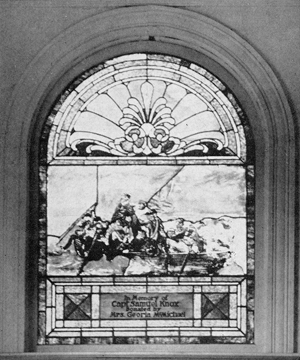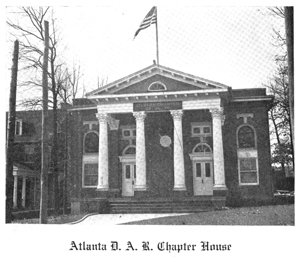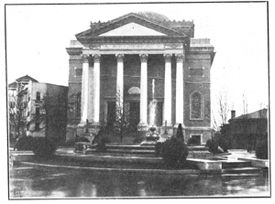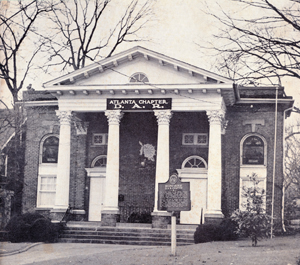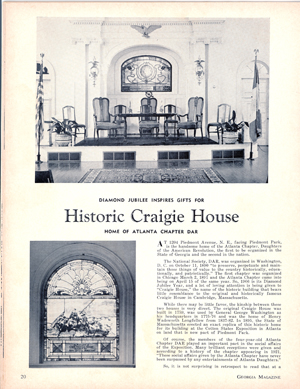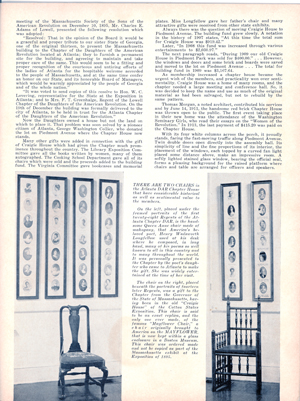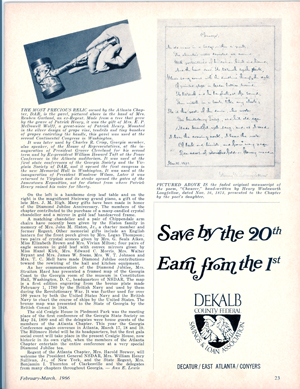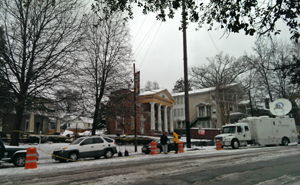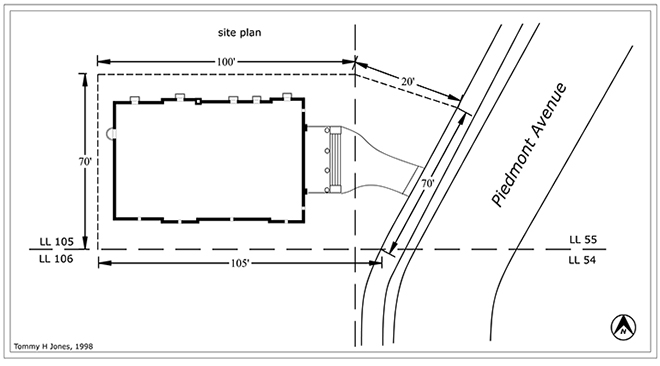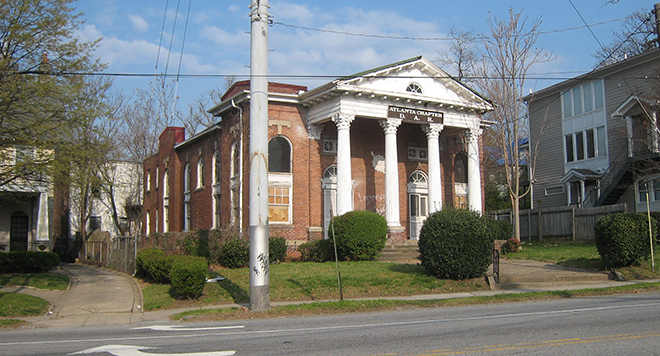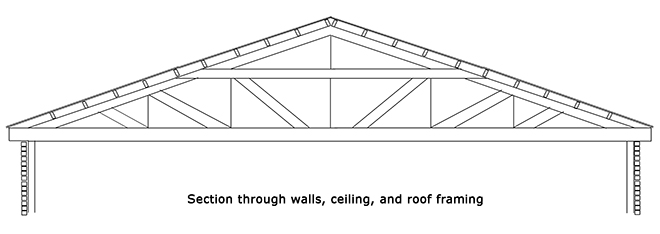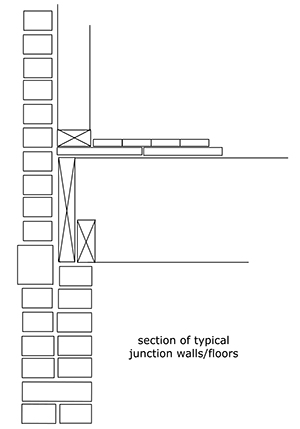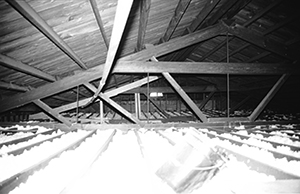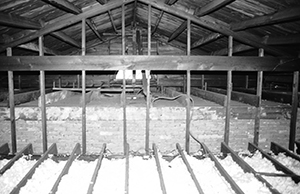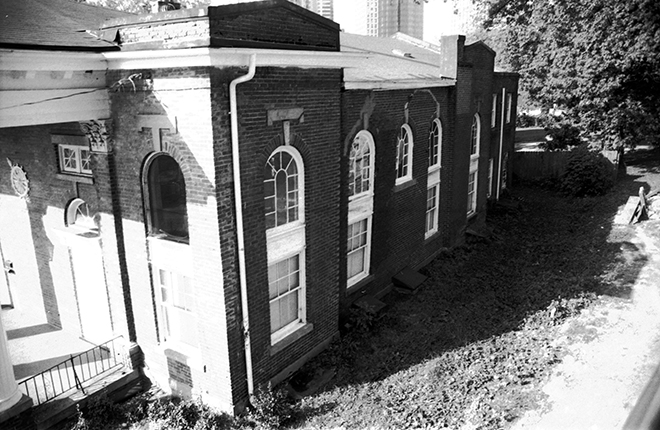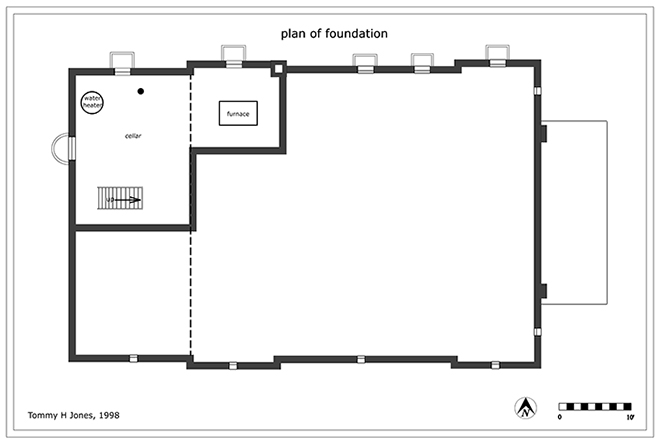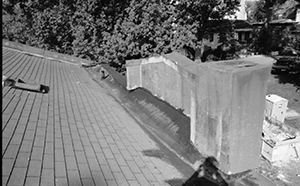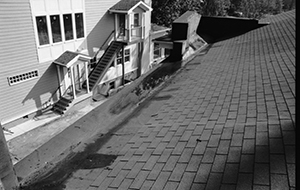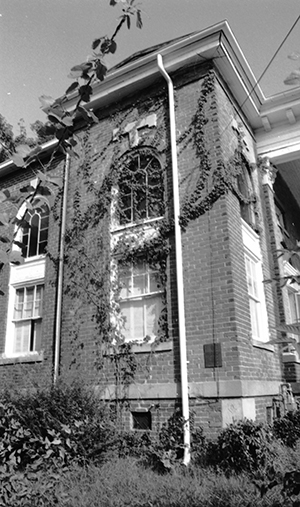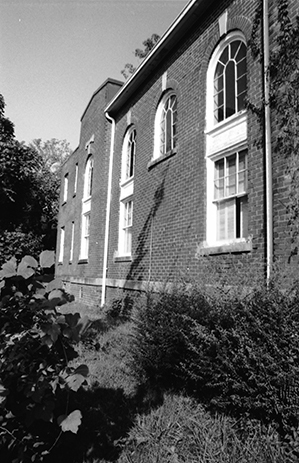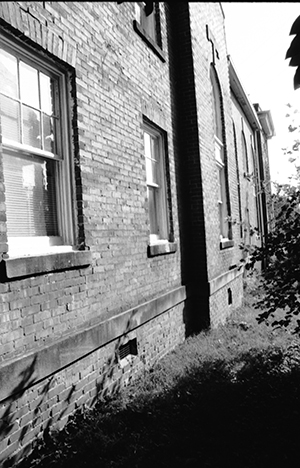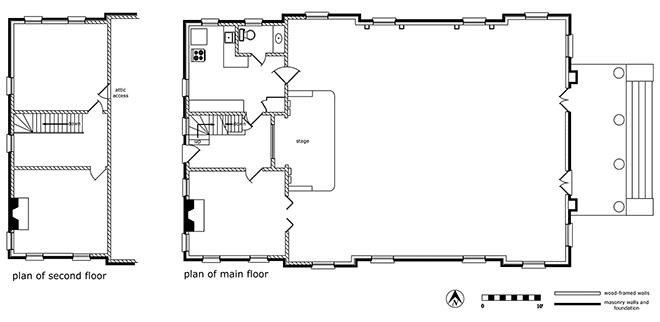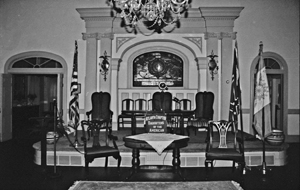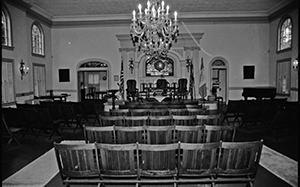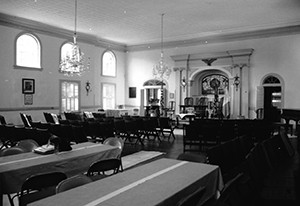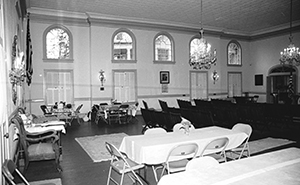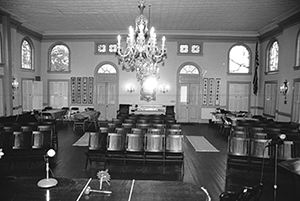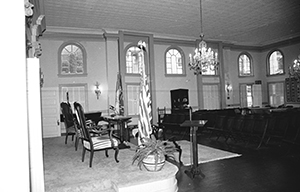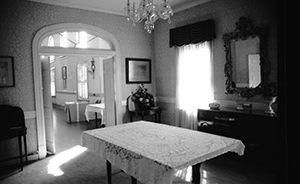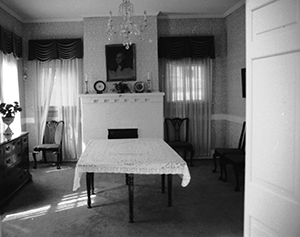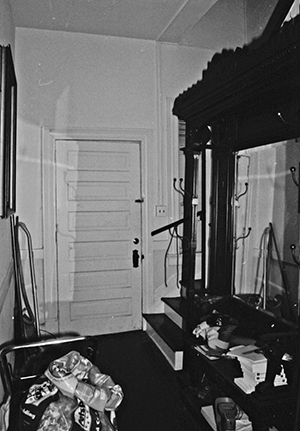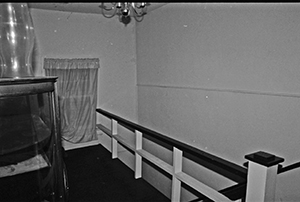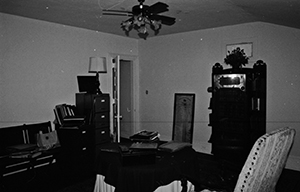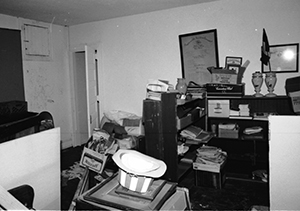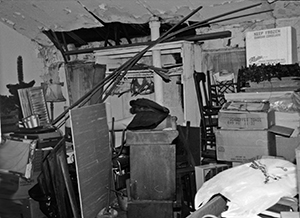On October 11, 1890, in response to the Sons of the American Revolution’s vote earlier that year to exclude women from membership in their organization, the National Society of the Daughters of the American Revolution was organized in Washington, D.C. Over the following winter, the original eighteen members—who included President Benjamin Harrison’s wife, Caroline Scott Harrison, as President General of the organization—solicited “Honorary Regents” in every state, each of whom was asked to organize local chapters. The first chapter was organized in Chicago on 20 March 1891 and the second chapter in Atlanta on April 15 that same year.[1]
In early June 1891, the national organization was officially incorporated and the DAR quickly gained a reputation as one of the country’s premier patriotic organizations. In addition to being the second chapter organized, the Atlanta chapter was the first DAR chapter to have its own chapter house. That first house no longer exists, but the present building remained a landmark on Piedmont Avenue until most of the building collapsed under the weight of ice and snow in February 2014.
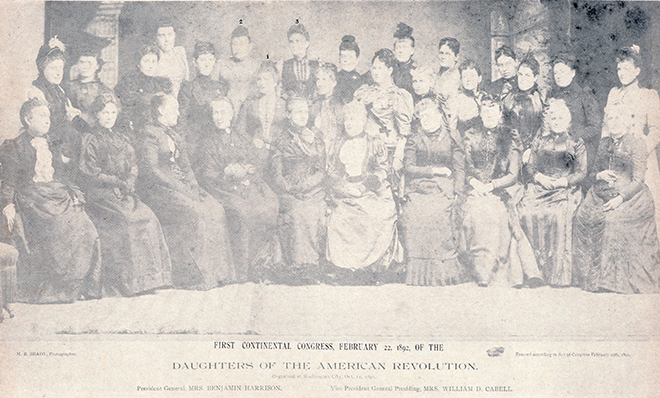
Figure 1. The First Continental Congress of the DAR, held in Chicago in 1892 with three women from Atlanta in attendance. (Chapter Archives, published in Georgia Magazine) |
Piedmont Park
Development of what is now Midtown Atlanta began in the 1870s and was in full swing by the mid-1880s as streetcar lines, which were all electrified by 1890, began running out Peachtree Street, W. Peachtree Street, and Ponce de Leon Avenue. In 1887 Benjamin Walker sold most of his father’s old farm in Land Lot 54, a couple of miles north of downtown, to the newly organized Gentlemen’s Driving Club. They adapted the Walker’s old stone house on Plasters Bridge Road (now Piedmont Avenue) as a club house and graded a great oval horse track out of the hill behind the house[2]At the same time, an agreement was reached to use a large portion of the property for the city’s Piedmont Exposition, which was held in October 1887. Chosen partly for its location on the Air Line Railroad, which ran along the east side of the property, the exposition was meant to showcase the natural resources of the southern piedmont in the Carolinas, Tennessee, Alabama, and Georgia. The site of the exposition was quickly dubbed Piedmont Park.
The Exposition’s success, which included a visit by President Grover Cleveland, spurred private and public development in the area, including rerouting Plaster’s Bridge Road south of Tenth Street to connect to an extension of Calhoun Street, all of which was renamed Piedmont Avenue in honor of the exposition.
|
Figure 2. View of Piedmont Driving Club, 1919, located across Piedmont Avenue from Craigie House. (Vanishing Georgia Collection) |
|
Figure 3. Detail of 1892 bird's-eye view of Atlanta, showing Piedmont Park as it was initially developed for the Piedmont Exposition in 1887. The arrow indicates the future site of the DAR chapter house. (Atlanta History Center) |
|
Figure 4. "Plan of Piedmont Park" as it was developed for the 1895 Cotton States and International Exhibition, with arrow indicating location of the Massachussetts reproduction of Longfellow's Craigie House. (Atlanta History Center) |
|
Figure 5. Contemporary view of Longfellow's Craigie House in Cambridge, Massachusetts. (Longfellow National Historic Site) |
|
Figure 6. View of Craigie House as it was recreated in Piedmont Park for the Cotton States and International Exposition in 1895. (Chapter Archives) |
The Cotton States and International Exposition
In 1895, as the country struggled to emerge from one of its worst economic depressions, Atlanta held another, much larger exposition at Piedmont Park: the great Cotton States and International Exposition. Planning began in December 1893 and was reportedly inspired by the Inspired by In addition to the several large exhibit halls erected by the exposition company, there were smaller structures and exhibits sponsored by other states as well as a few Central and South American countries. One of the state buildings was erected by the State of Massachusetts.
The details of Massachusetts’ participation in the exposition have not been researched, but the building they constructed was said to be an "exact copy” of Craigie House (1759), the famed Georgian mansion in Cambridge, Massachusetts, that had been Washington’s first headquarters in the Revolutionary War and which gained later fame as the home of Henry Wadsworth Longfellow.
Located on a steeply sloping site just north of the Manufacturer’s Building, which was the Exposition’s largest building, the Craigie House replica was reported to have cost the state of Massachusetts $10,000 to construct and was described as “a permanent structure and . . . handsomely decorated on the interior.” Unlike its prototype, which is a timber-framed building, the replica of the house that was built in Piedmont Park most likely had a conventional balloon frame. Because of the steep site on which it was built, the house sat on a series of wooden posts that were perhaps as high as twenty feet in the rear.
The Cotton States Exposition opened on 18 September 1895 with a variety of speakers, including Booker T. Washington, who electrified a segregated audience with his speech on race relations. The Exposition featured some 6,000 exhibits in a half dozen major buildings and a variety of smaller ones, including Craigie House. By the time it closed on New Year’s Eve 1895, there had been as many as 800,000 visitors, with 55,000 crowding the grounds for Atlanta Day.
The First Chapter House
Even before the Exposition closed, the Massachusetts Board of Managers for the state’s replica of Craigie House was exploring disposition of the house. The house and its contents were advertised for sale in the Atlanta papers, but there were no takers and, realizing that they would probably get only a few hundred dollars at best, the board decided to donate the building to the Atlanta Chapter of the DAR, complete with electric light fixtures and bookcases. It probably had no plumbing or heating and all of the furniture was to be offered for sale as well.
In October 1895, in ceremonies before Mayor Porter King, W. C. Lovering, chairman of the Massachusetts Board of Managers for the Exposition, presented the building to the City of Atlanta to be held in trust until the Atlanta chapter could secure its charter from the State of Georgia. According to the newspaper accounts at the time, "the members of the Daughters of the American Revolution have arranged with the Piedmont Exposition Company to let the building remain where it is until they can secure a lot when they will have it removed."[3]
In February 1896, reportedly through the efforts of "Madame Preschaska of Austria" (formerly Mrs. William Dickson of Atlanta), George Washington Collier gave the Chapter "a big lot for their home." Located in the southeast corner of land lot 105, it was part of several hundred acres of mostly undeveloped land that Collier owned north of Fourteenth Street, but the lot itself measured only 100’ by 100’.[4]
At the same time, Benjamin Walker donated a small parcel to the east of the Collier lot, which gave the DAR’s property frontage on Piedmont Avenue. [5] In addition, the newspaper reports of the gift stated that "25 feet has been given for the purpose of opening a wide street which will lead from the club house direct into Peachtree. This is a great advantage and will increase both the value and beauty of the property and all adjoining grounds.” The new street, which Collier had suggested in his deed, did not materialize.
The chapter’s report also stated that the building was to be moved “right away” and that "the county commissioners will relieve us from tax and we will ask the legislature for release from state tax. Mr. Fulton Colville has secured our charter for us and the deeds are to be recorded at once."[6]
However, both deeds included clauses whereby the property would revert to Collier and Walker or their heirs should it ever cease to be used for the Chapter’s house. Upon reflection, the Chapter decided that these restrictions, which meant that they could never sell the property, were unacceptable and so did not formally accept the gift at that time.[7]
The following year, 1897, was spent in furnishing Craigie House, but the initial enthusiasm for the project and the planned move must have been short-lived, since the house was still on its original site in Piedmont Park when it was formally opened to the public on Washington’s birthday in 1898. The costs of moving the building were far more than anticipated, and the logistics of dislodging it from its site and trundling it across the park to its new site would not have been simple. The matter of moving the house was again discussed in 1899 when the chapter hosted the first conference of the Georgia DAR, “but nothing [was] done” according to the chapter history.
In addition, there was no heat in Craigie House, which forced the chapter to meet at other sites, including "Symphony Club" hall, during the winter months. It is probable, too, that the building was something less than the "permanent” structure that the donors claimed; and other problems with the building, besides the absence of heat, must have forced the decision that it would be better to build anew rather than move the building as originally planned.
Fundraising began in 1903, perhaps in anticipation of the city’s purchase of Piedmont Park from the Exposition Company in 1904; and, in April 1903, the chapter was reminded of Collier’s donation in 1896. Unfortunately, Collier died in June before the matter could be resolved. The several hundred acres of “Collier’s Woods” north of Fourteenth Street had long been coveted for development and, in an unusual set of circumstances, Collier’s will was overturned and the entire land lot was sold at public auction. The new owner was the Southern Real Estate Improvement Company, which began development of Ansley Park in 1904. In the process of checking their title to the property, Collier’s original deed of gift resurfaced and was offered again by the Improvement Company. This time, the Chapter enthusiastically accepted the donation, which was formally made on 25 October 1904.[8]
Benjamin Walker’s daughter Mrs. Lola A. (Frank) Clement, however, had inherited the small parcel between the Collier donation and Piedmont Avenue and, unlike her father, was unwilling to make an outright donation. Not until December 1905 did the Chapter agree to swap a 30'-wide strip from the north side of their lot for the smaller parcel that would give them frontage on Piedmont Avenue. The deed done, the Chapter finally had title to all of the present site of the Chapter House.[9]
The following year the city’s building inspector reported that the Exposition buildings were deteriorating and that some in fact needed to be demolished. The Fine Arts and New York State exposition buildings burned in 1906, heavily damaging the adjacent Driving Club at the same time. By then, it was clear that the chapter must prepare to move and a fundraising campaign in 1908 brought the total in the “Craigie House fund” to $2,000. By the time the Olmsted brothers began their survey of the Exposition grounds in the summer of 1909, all of the buildings were gone, including Craigie House, sold by the Chapter for $400. The building was apparently torn down for its materials soon afterward, although windows, doors, and “some brick and boards” were salvaged and moved to the lot on Piedmont Avenue. It is not clear if any of that material was re-used in constructing the present building.[10]
Craigie House
Mrs. Joseph H. Morgan, the chapter's "beloved Mother Regent," had headed the chapter's building committee since 1895 and was credited with making construction of a new chapter house possible. Mrs. Thomas H. Morgan (no known relation) served as Regent in 1906-1907 and probably persuaded her husband, one of the city's most prominent architects, to donate his services for the new building.[11]
The precise extent of Thomas Morgan's involvement in the project is not known but most likely included floor plans and perhaps one or two elevations. Founding president of the local chapter of the American Institute of Architects, Thomas Morgan(1857-1940) formed several partnerships over his long career, which began in 1879 and ended with his retirement in 1930. Among his credits are Concordia Hall (1893), Century Building (1901-02), the Empire Building (1901), North Avenue Presbyterian Church (1901), All Saints Episcopal Church (1903), Rich’s Whitehall Street store (1907), the Third National Bank (1911), and the Healey Building (1913).
Although fundraising was slow, by the fall of 1910, a little over $3,100 had been raised, enough that preparations for construction of the new Chapter house were begun. In August 1910, Samuel Venable, who owned part of Stone Mountain and was a pioneer in the South’s granite industry, gave the chapter a granite cornerstone for the new building, construction of which had not yet begun.
On 7 October 1910, the DAR applied for a building permit and construction must have begun about that time. Three days later, Mrs. S. W. Foster donated a stained-glass window as a memorial to the Founders of the Atlanta Chapter, Mrs. Martha Berrien Duncan and Miss Julia McKinley. In December, Mrs. Georgia McMichael and Mrs. Eula Griffin donated a pair of memorial windows that would be installed at the front of the chapter house. Numerous other donations of furniture, books, and decoration were also received as construction continued through the fall and winter.[12]
On 17 December 1910, work had progressed to the point that the cornerstone could be laid “with Masonic Ceremony by George M. Napier, Most Worshipful Grand Master,” before “a large assemblage of members and friends of the Chapter.” Mrs. Joseph H. Morgan, who had again been elected Regent, gave the Chapter’s history and, afterwards, sealed a written copy of it in the cornerstone. By then, too, they had decided to call the new chapter house “Craigie House” in honor of the old.[13]
On 20 April 1911, the building permit was marked “completed” but, “owing to financial condition” of the Chapter, the builder G. A. Goodrich was forced to turn over "an unfinished building." It is not clear what remained unfinished, but additional fundraising appears to have made possible finishing the house to the extent that it could be formally opened on 14 June 1911.[14]
The Chapter still may have been unable to use the house on a regular basis, however, at least until the University Club donated two gas heaters in September 1912. By the time the chapter made its last payment on the new house in 1913, the members had raise $40 “for additional heaters” in the house.[15]
Two years later, Mrs. J. M. High who was serving as Regent, funded installation of a new roof on the house, indicating that part of the unfinished work from 1911 was a durable roof covering. Although the original building permit had stated that the building would have a metal roof, it is likely that a less-expensive alternative was necessary in 1911. No description of Mrs. High’s roof, “which was much appreciated,” has been located.[16]
At the same time, the Chapter was able to “remodel” the interior at a cost of $565.66.[17] The extent of this work has not been documented but it is likely that this expenditure covered installation of the present metal ceiling and cornice which are installed over the original plaster-and-wood-lath ceiling in the main hall.
With the outbreak of World War I, the Chapter devoted themselves to the war effort, but by the early 1920s, the Chapter was again adding to the furnishings and decoration of Craigie House. In October 1922, the Chapter dedicated the two bronze plaques on the west wall of the hall, one a memorial to the Common-wealth of Massachusetts and the other a memorial to George Washington Collier and Benjamin Walker.[18]
In the early 1920s, the Chapter appears to have augmented its income by renting the house to “Mr. Arthur Murray, for the use of his select dancing class twice a week.”[19] Murray (1895-1991) moved to Atlanta in 1919 to begin classes in business administration at Georgia Tech and went on to found a famous ballroom dancing studio. How long he used Craigie House as a studio is not known.
In 1928, “a new roof was put on, and the interior walls of the auditorium decorated, the gift of Mrs. Charles F. Rice in the sum of $367.00."[20] That a new roof was required so soon is a good indication that the Chapter was never able to afford the metal roof that was originally intended and which would have had a life expectancy of at least fifty years.
Although there was probably little done to the house during the 1930s, the Chapter continued to acquire furnishings including the Steinway grand piano which was played for the first time on 15 December 1934. As the 1941 inventory of gifts suggests, the Chapter has owned a large collection of books, furniture, and decorative and historic objects, including many items acquired from the Exposition in 1895. Some of these donations remained in the house until it was sold.
Like many historic buildings, Craigie House appears to have been badly neglected during the Depression and massive structural damage ensued. It is also possible that cost-cutting during the course of construction may have contributed to the severe structural problems that developed with the building. Surprisingly, however, documentation for the major repairs that were completed by 1950 has not been located in the Chapter archives. A photograph from 1950 shows that the pilasters that were installed to disguise structural repairs to the north wall were in place at that time. These appear to have been part of major repairs to the building’s wood frame that had been badly damaged from rot and termites.
In 1940, the gas heaters that had been installed in the main hall in 1912 were replaced by a new gas-fired furnace. The exterior woodwork and gutters were also repaired around this time.
In 1966, in honor of the Chapter’s Diamond Jubilee, the house received “a lot of loving attention.” The interior of the building was completely redecorated, the kitchen and bathroom were renovated, and the building was rewired. In the main hall, the original ceiling lights and sconces were replaced by the present pair of crystal chandeliers and Colonial sconces. On the front porch, a ceiling-hung “English [21]
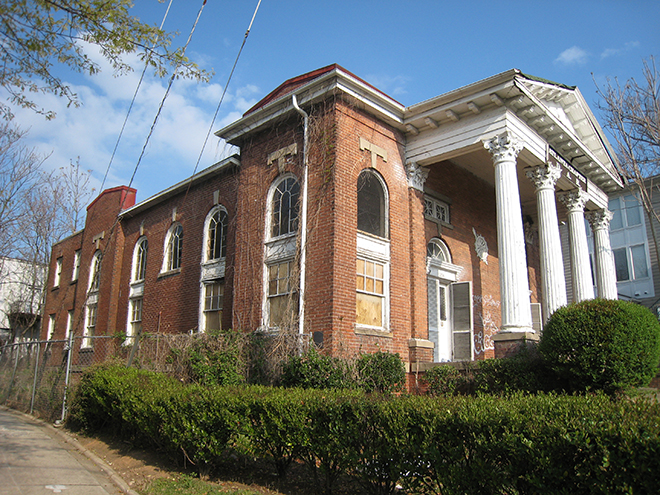
Figure 14. Craigie House, 2008. (Author's photograph) |
|---|
Maintenance of and improvements to the site continued to be financed by “gifts” from the membership but with declining membership and changing demographics, particularly after the 1960s, this source of financial support for building upkeep slowly dwindled. In 1986, the building was heavily damaged by a magnolia tree that fell against the north side of the building, breaking one of the main roof trusses and doing further damage to the already-damaged wall on that side of the house. The building was briefly threatened with demolition but repairs were made possible by financial assistance from Josh Thomas, WXIA, the Atlanta Journal-Constitution and Mr. Bob Williams. C & B Fire Contractors repaired the roof and the house reopened in March 1988.
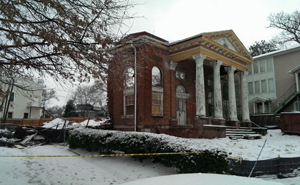 |
|---|
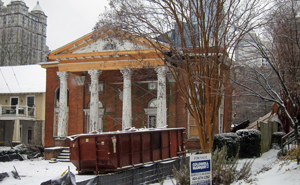 |
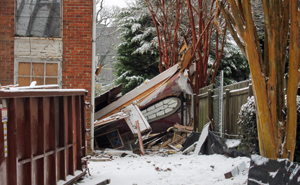 |
|
Figures 15-18. Craigie House, February 2008. |
In 1990 a new roof covering was installed and the exterior woodwork was repainted. In addition, some new landscaping was installed, funded by the Hyde Foundation of Memphis, Tennessee, Southern Bell, and other businesses and private individuals. In 1991, the stair halls at the rear of the building were repainted, but in 1994, additional damage to the building occurred as a result of Hurricane Opal, which forced removal of two of the stained-glass windows.
In the fall of 1999, additional investigation by an engineer confirmed the precarious condition of the north wall, and the decision was made to vacate the building. The memorial stained-glass windows had already been removed, and repairs were beyond the chapter’s means. In 2001 the property was sold to a private developer, who subsequently went bankrupt. The building remained vacant, its windows boarded up, grafitti on the brick walls, and continued to deteriorate.
In April 2004, the Atlanta Chapter of the DAR sold Craigie House to Inman Park Properties, a real-estate development company that had successfully renovated several historic buildings in Atlanta. Before any work could take place, the company became over-extended as the economy collapsed in 2008 and the property went into foreclosure. For the next five years, the building was not properly secured and much of the interior flooring and other woodwork was stripped from the building during that period. Mostly intact, the exterior of the building continued to deteriorate.
In 2013, Bert and Laura Sanders purchased the property for $350,000 and began work to rehabilitate and adapt the building as their residence. Significant repairs had been made to the front of the house by 12-13 February 2014 when a severe winter storm rolled across the southeast, bringing significant sleet and freezing rain to Atlanta before ending with two inches of snow. The building's roof had a very shallow pitch and was poorly drained, leaving most of the precipitation on the roof. Around 9 PM on 12 February, the load of ice and snow caused both north and south walls of the structure to collapse outward, which brought down the entire rear of the building as well. The side walls that supported the two roof trusses in the attic broke away from the front of the building, which remained standing along with the portico.
The owners vowed to rebuild and are thought to have applied for a building permit to continue work in June 2014. The site was cleared and stablized, but additional work was not forthcoming. What remained of the building was removed in March 2016. [22]
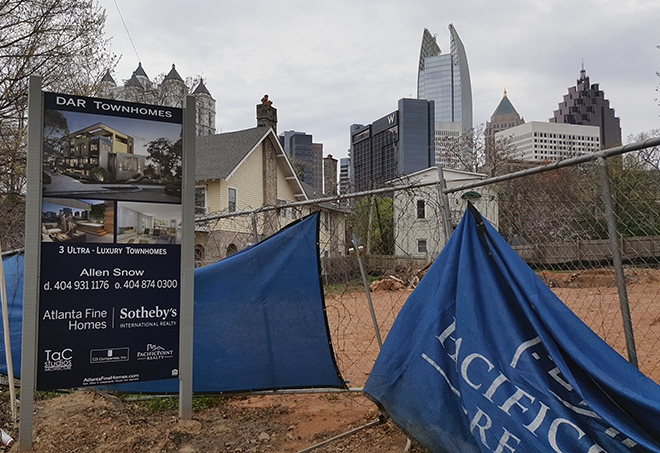
Figure 19. The site of Craigie House, 10 March 2018. |
|---|
Architectural Description
Unless otherwise noted, all photographs in this section were taken in 1999.
This description of the building is based on building investigation and assessment of conditions as they existed in 1999. Since that time, the house continued to deteriorate until most of it collapsed in February 2014. The original report was meant to help identify features that contribute to the building’s historical significance and which, therefore, should be preserved wherever possible as the building is repaired and rehabilitated. The final section of the original report included a detailed condition assessment and recommendations for repairs and future treatment of the building, all of which has been omitted from the present document.
|
Figure 20. Plan of site, including land lot lines. |
|---|
Site
Although the site was donated to the chapter in 1896, acceptance and actual transfer of the property did not occur until 1905, after the deaths of the original donors. As a result, the lot as it was actually acquired by the Chapter, had only 70' of frontage on Piedmont Avenue and not the 100' that Collier and Walker had originally stated. The site slopes gently from north to south with the house facing east and nearly centered in the lot.
The house is approached by two 12'-wide concrete steps from the sidewalk along Piedmont Avenue. The walkway itself, which widens to meet the front steps to the portico, is paved with hexagonal concrete pavers, most of which appear to date to the house’s original construction. A number of these have been recently replaced with a modern red concrete pavers. The site has never had a driveway or off-street parking.
|
Figure 21. A view of the cramped site of Craigie House, 2008. |
|---|
A 7'-wide sidewalk and 3'-wide “greenway” separate the front yard from Piedmont Avenue. Mounted on the northeast side of the front yard is a Georgia Historical Commission plaque which commemorates the Atlanta Chapter’s status as the second oldest in the country and the oldest in Georgia. It was installed in 1953.
The Chapter’s records contain evidence of a variety of plant material that was once planted on the site, including ivy from the grave of Robert E. Lee and Japanese bamboo. However, most of the existing plant material appears to be of modern origin and most of it is in poor condition. The old wire fence on the north side of the property has recently been removed and the underbrush cleared away, but the south line is badly overgrown and kudzu has taken root at the rear of the building.
Surface runoff of water is uncontrolled across the site from the properties to the north. Gutters and down spouts are absent from the building. As a result, surface drainage is extremely poor around the foundation of the house, especially along the north side. This condition has contributed directly to major structural damage to the building in the past (see below). The ground around and under the house remains damp for long periods of time which precipitates “rising damp” (i.e., water wicked up through masonry) in the foundation. Rising damp will dissolve the mortar between the bricks and sills and joists that are in contact with this damp masonry are subject to rot. In addition, the generally damp conditions around the house create ideal conditions for continued settlement of the structure and for repeated termite infestations under the house.
|
Figure 23. Section through lower wall. |
Structural System
The basic structure is a conventional, brick-veneered, wood frame built on a brick foundation. Floor joists are 2" by 10" on the first floor, where they are supported by the perimeter foundation and a pair of large internal sills set on brick piers and running the length of the building. Second-floor joists are 2" by 8" and walls are balloon-framed with 2" by 4" studs.[22]
On more than one accession in the past, the wood frame of the building has suffered major termite and water damage, with numerous old repairs to floor joists and sills visible in the cellar and crawl space beneath the building. The condition of the internal wall structure could not be investigated but the character of the visible framing repairs indicates that some old damage may remain unrepaired inside the walls.
The ceiling joists (2"by 8") and roof rafters (2" by 6") above the main hall run east-to-west and are supported by the end walls of the building and a pair of six-panel, Howe trusses that span the width of the building and divide the main hall’s ceiling/roof structure into unequally-sized thirds. The bottom chords of the trusses are built up with triple 2" by 12" lumber; the upper chords are built up with triple 2" by 10" lumber. Struts are triple 2" by 10” with vertical iron bars, 1¼" in diameter for the center strut and ⅞" diameter for the remainder.
|
Figure 24. View of the north end of the broken truss. |
|---|
|
Figure 25. View of stud wall between the rear rooms in the foreground and the hall beyond. |
The upper and lower chords of the truss over the eastern (front) portion of the building were broken at the second panel on the north side when the tree fell in 1988. Repairs were not well-made and the repaired upper chord has broken again, with evidence still present of continued movement and instability in the vicinity of this damaged truss.
While the broken truss is obvious cause for concern, the condition of the entire north wall of the building, upon which both trusses rest, is not good. As noted above, there appears to have been major restructuring of this wall in the 1940s. Although the extent of that restructuring cannot be fully ascertained without removal of interior plaster and lath or exterior woodwork, it appears that fundamental problems with the structure had developed by that time—probably due to insect damage and rot but, perhaps, also to cost-cutting efforts when the building was under construction in 1910-1911.
In particular, three or more trusses may have been originally intended to support the roof and ceiling of the main hall but only two were installed, both bearing on the wood-framed north wall at points above large window openings on that side of the building. This change might not have caused problems until water and termite damage in the 1930s weakened the wall and, as it settled, the natural thrust of the trusses began to force the top of the north wall outward, threatening collapse should the truss lose its bearing on the side wall. The four pilasters that were installed on the interior of the north wall prior to 1950 appear to conceal structural members that were installed to stabilize the wall. The full nature of this added framing, which is probably wood, is hidden from view but large top and bottom plates are visible in the attic and in the crawl space where the plate rests on brick piers added in the crawl space next to the foundation. The added top plate is probably supported by two or more wood or metal posts concealed inside the pilasters. This added structure provides support for both trusses and, essentially, bypasses some of the original structural function of the north wall. The two large iron bolts and washers that are visible on the exterior behind the pilasters were probably added at the same time to tie the added posts to the original brick-veneered, wood frame of the building.
It is unclear if the north wall suffered further damage between 1950 and 1988, when the tree fell, but, at least by the early 1980s, serious bowing of the roof above the east truss was evident from the exterior. That the tree fell against that same area only compounded earlier problems. Today, evidence of the underlying structural problems with the building is clearly visible on the exterior and interior of the building. The bowing of the roof, which is especially visible from the south side of the building, coincides with but pre-dates the damaged truss. The same may be true of the large, arched window west of center on the north side of the building. Settlement of the surrounding wall has caused serious damage to the window opening and thrown the frame and sash seriously out of alignment. On the exterior on the north side, the brick veneer in the upper part of the wall has buckled or moved with the underlying framing and cracks in repaired areas of the veneer and in the metal ceiling on the interior indicate movement has continued to occur since 1988. In addition, some of the pilasters are severely out of plumb, although it is not clear how and when that deviation occurred. The two western pilasters are only an inch or two out of plumb but the tops of the two eastern pilasters, beneath the damaged truss, have pitched outward as much as four inches. None of the repairs since World War II appear to have addressed the underlying causes of the damage (especially, the poor exterior drainage and poorly-detailed roof).
Other areas of structural damage are also present in the building. In the northwest corner of the north room on the second floor, the roof or gutter leaks were left unchecked for a long period of time, perhaps in the 1970s and early 1980s. Besides destroying much of the plaster walls and ceiling on that side of the room, wall studs, top plate and rafters have also been heavily damaged. Significant deterioration of plaster and woodwork elsewhere on the interior is an indication of areas where there is the potential to find further structural damage. Particular areas of concern are on the south wall of the main hall between the two eastern windows and around the center window. These leaks, however, are probably not related to roof leaks but, rather, to deterioration of window sills and exterior woodwork.
Because of all of the moisture in the building and given the presence of much old damage (although some of it has been repaired), there is also a good possibility that termites continue to infest the building. The front sill, which is in near contact with the earth and/or rubble filled floor of the front portico, is also at some risk of termite damage.
|
Figure 27. Plan of foundation and cellar. |
|---|
Foundation and Cellar
Most of the wood-framed structure sits less than two feet above grade. The building is set on a continuous brick foundation, measuring about 67' east to west and 45' north to south, plus the portico, which is 26'-3" wide and projects 10' in front of the building. Brick piers provide support for interior walls.
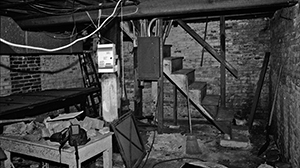
Figure 28. The cellar, looking south. |
|---|
There has been some abnormal settling of the building, particularly on the north side but also at the corners of the house. Most of this settlement is probably from poor drainage. Cracks in the stuccoed belt course around the corners and elsewhere indicate areas of differential settling of the foundation that often correspond to cracks in the brick veneer in the walls above.
The vents and light wells for the cellar and crawlspace appear to have been part of the original construction. The crawl space is vented through metal grills in the foundation on the south side of the portico and along the south side of the house. On the north side of the house, the openings are larger and admit more light and air and are protected by rectangular brick wells and iron grates. At the rear there is a larger, semi-circular light well covered by an iron grate. Galvanized sheet metal covers, probably installed in the 1960s, are attached to the walls of the house a few inches above the brick curb of the wells. These covers keep out rain water while still admitting some light and air but some are not in good repair and, in any case, do not exclude the entry of rodents and other small animals.
Roof
The building’s main gabled roof is partially hidden by a simple parapet wall that surrounds most of the perimeter of the building and which features shallow pediments along the sides that give the impression of a cross-gabled roof. Because of the truss damage and other structural problems noted above, a pronounced bow is evident in the ridge line of the roof, with a deflection as much as 6" deep above the damaged truss. Although the original building permit specified a metal roof for the building, it apparently has always been roofed with asphalt or other composition shingles or roll roofing. The present roof covering is 3-tab, asphalt shingles, which were installed in 1990 and remain in good condition except around the perimeter of the roof.
|
Figure 29. View of the northwest side of the roof. |
|---|
|
Figure 30. View of north side of roof, looking east. |
Essentially rectangular in shape, the main roof was designed to shed water toward a simple wooden soffit, about 19' long, that interrupts the parapet wall on each side of the building. A through-wall scupper and downspout was located at each end of the rear (west) but one of these has been removed and the opening sealed and the other may no longer be operative. Gutters and down spouts appear to have been an original feature of the building and still remain in place on either side of the front portico and on the south side of the house. On the north side, gutters were damaged and not replaced in 1989. Roof runoff on the north side of the building, after cascading across the wall, collects against that side of the building and, during very wet weather, probably floods the cellar and parts of the crawl space.
In addition, the settlement and repairs to the north wall of the building have left low spots along the edge of the roof which allow water to stand for long periods of time. Inevitably, this leads to slow leaks, especially when associated with badly-maintained flashing of the nearby parapet walls.
Exterior Walls
The exterior of the wood-framed walls of the building are veneered with a reddish brick, with 2-1/8" x 8'-1/4" face, 3/8" mortar joints, and laid in running bond. A hard, lime-based mortar, tannish in color, was used originally, although there have been a number of modern repairs using a hard, grey, Portland-cement, mortar. The tops of the parapet walls, which were originally finished with concrete coping, are now mostly capped with sheet metal coping, painted red.
|
Figure 31. The southeast corner of Craigie House. |
|---|
|
Figure 32. South side of Craigie House, looking west. |
|
Figure 33. South side of Craigie House, looking east. |
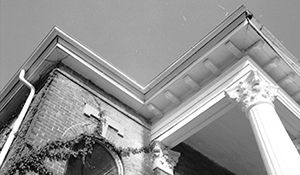
Figure 34. South side of portico. |
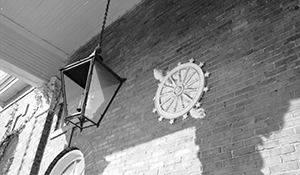
Figure 35. Portico lantern and medallion. |
At the southeast corner of the building is a granite cornerstone. The inscription on the east face reads: “Atlanta Chapter DAR, Organized April 15, 1891, Building Erected 1910, Mrs. Joseph H. Morgan, Regent, Miss Katherine B. Massey, Chairman Board of Management, Building Committee [of] Mrs. J. N. Bateman, Chairman, Mrs. S. W. Foster, Mrs. Archer Avary, Mrs. F. H. Orme, Mrs. George M. Hope, Mrs. Stonewall R. Jacobs.” The south face is inscribed with the Masonic symbol and “A. L. 5910, Grand Lodge of Georgia, F. & A. M., December 18, A.D. 1910, Geo. M. Napier, Grand Master.”
The masonry is extremely soiled over all of the building and mortar has been damaged in several areas from rising damp and surface erosion, particularly on the north side of the building. Differential settlement of the structure has produced significant cracks above the south bay on the front, where brick have been dislocated, and around the southwest and northeast corners of the building. The parapet wall at the northwest corner has been destabilized by the damage to the roof and wall framing below.
There is evidence of several earlier repairs to the masonry, most of which were neatly done. Major repairs are evident in the vicinity of the old chimney flue on the north side However, the most recent repairs used modern grey mortar, which does not match the original and which were very poorly executed.
Portico and Trim
The Neo-Classical design of the building is established by the handsome portico and its four Corinthian columns that support a low Classical pediment. Set on low brick piers, the columns are wooden, stave-built and fluted, and measure about 22" in diameter and 15'-8" from the top of the pier to the top of the capital. There have been several repairs to the wooden bases of the columns but moisture penetration from poorly-maintained caulked joints as well as the placement of the columns directly on the concrete pier caps continues to cause deterioration.
The portico’s soffit and ceiling were originally finished with double-V-joint, tongue-and-groove boards, about 3-1/4" wide; but some of the soffit boards around the northeast side of the building have recently been replaced with double-beaded boards. Large, plainly-scrolled brackets, 18" long and cut from 6" x 6" stock, were used on the eaves of the portico and its pediment but not continued on the remainder of the eaves, which continue only part way down each side of the building. One of these brackets recently fell and is now in storage; another is missing entirely .
The remainder of the cornice, which extends across the front and part of the way down each side of the building, is un-bracketed. The soffits on the sides of the building behind the front block appear to have been completely rebuilt and their original character has not been determined.
The floor of the portico is paved with 8" hexagonal pavers that appear to be laid on earth and/or rubble fill. The pavers are uneven in places but in generally good condition otherwise. Four concrete steps set between low brick buttresses with concrete caps span the width of the porch. Cast-iron railings, which may not have been a feature of the original building, now surround the front porch and flank the front steps. Similar railings are also found at the steps to the sidewalk and Piedmont Avenue. Pigeons roosting on top of the columns have soiled much of the portico floor and surrounding areas.
Openings
Doors: Two door openings under the portico, which form the main entrances to the building, are set within tall arched openings and include doors, set in pairs and measuring 2'-0" x 7'-6". The door openings are surmounted by a cornice that is similar to the design of the cornice of the single front door at the original “Craigie House.” At the top of each opening, above the cornice, are four-light, arched transoms. Pairs of louvered screen doors were added to both openings in 1966, none of which now function properly. The back door is a five-panel, wooden door, 2'-6" x 7'-0", and is deteriorating due to lack of paint on the exterior. .
Windows: Above the door openings are small rectangular window openings, each set with a pair of fixed, six-light sash with a triangulated muntin design. Tall arched window openings on either side of the portico are divided in such a way as to appear to light a two-story structure although the assembly hall on the interior rises the full height of the building. Wooden arched sash in the upper portion of these windows were, until recently, glazed with memorial panels of stained glass. Installed when the house was built in 1911, these windows were damaged by Hurricane Opal in 1995 and removed for repairs. Beneath the stained-glass is a molded wooden panel and, at the bottom of the opening, 6/1 double-hung sash, 3'-10" x 5'-6".
The design of these window openings is repeated on both sides of the main hall of the building but with the stained glass replaced by wooden sash with ten, clear lights. In addition, in the center bay on each side, the opening is shortened by the omission of the double-hung sash and wooden panel.
All window openings on the building have concrete sills and keystones, except on the flat-topped openings at the rear of the building where the keystones are omitted. Keystones at the front of the building are T-shaped while the remainder are simple lozenge-shaped.
In the two-story block at the rear of the main hall, all openings are rectangular with double-hung, 6/1 sash, 2'-10" by 4'6". In the two southern bays at the rear of the first floor, small casement-type windows 2'-10" x 3-2". Although most of the original material of the windows remains intact, all of the windows are deteriorating. Glazing putty is cracked and missing and heavy build-up of paint has rendered nearly all of the sash inoperable. Caulked joints have opened and paint has eroded to bare wood, especially on the south side of the building. Several sills are rotting as a result and are in such poor condition that they are allowing water to penetrate the walls. In at least two windows on the south side, water penetration is damaging the interior plaster walls as well. Some of the wooden panels between the upper and lower windows are cracked and are missing elements of trim. As noted above, structural problems on the north side of the building have caused racking of some of the window frames, which is especially apparent in the large window at the fourth bay from the rear. Broken glass in the lower sash of the bathroom window has been replaced with an aluminum-framed storm window.
|
Figure 36. Plan of first and second floors. |
|---|
Interior
Most of the interior of the house has remained in relatively good condition, excepting the cellar and the northwest room on the second floor, both of which are in very poor condition. The original plan and nearly all of the original features and finishes remain intact throughout the building, although the kitchen and bathroom were completely remodeled in the 1960s. Lighting and plumbing fixtures were generally replaced at that time, but the bath tub in the basement and an electric sconce found in the attic may be original features of the house.
From the exterior, the design of the building conceals the fact that it is essentially one large, single-story meeting hall with a smaller two-story block of rooms at the rear. The main hall encompasses nearly 2,000 square feet of floor space with an additional 1300 square feet in the rooms at the rear.
The main hall features a platform at the west end, raised about 14" from the floor of the hall, with a wood-paneled skirt, and reached by steps from each side. At the rear of the platform is a wide arched opening that frames a shallow, paneled alcove and a large memorial window in stained glass.
On the south side of the stage, folding doors open into the dining room, which features a brick fireplace; on the north side, a swinging door opens into the L-shaped kitchen. Both of these door openings feature fanlights. The bathroom is located on the northeast side of the kitchen and both the kitchen and the dining room are connected to the stair hall. The stair hall, which includes the back door to the building, connects to stairs to the cellar and to the second floor. The southwest room on the second floor houses the Chapter’s archives and some of the books that remain in its collection. The northwest room on the second floor is in poor condition and used only for storage.
Walls and Ceilings
Walls and ceilings are plaster on wood lath, originally sand-finished and painted, except in the main hall where the original plaster ceiling was covered by the present stamped-steel ceiling around 1915. The ceiling in the main hall is nearly 18' high; those in the rear rooms on the first floor are 10'-8". The second floor ceilings are 8'-10" high, sloping beneath the roof to the tops of the windows on the side walls. As noted above, water penetration from the exterior has caused serious damage to the plaster walls at several locations in the main hall and major destruction of part of the plaster ceiling in the northwest room on the second floor. A large crack in the center of the south wall is an indication of underlying structural problems but elsewhere, the plaster is in reasonably good condition for its age. The lower part of the walls in the kitchen are covered by black and white, plastic tiles that were probably installed in 1966.
Flooring
Flooring is all wood, tongue-and-groove, mostly painted, except where covered by wall-to-wall carpeting in the dining room and vinyl floor coverings in the kitchen and bathroom. In the main hall, rectangular patches are evident around the northeast side of the hall. One of these, near the center of the hall, was cut for a gas-fired floor furnace. The other, nearer the north wall, may have been opened to facilitate repairs to that wall in the 1940s. Exposed flooring is worn but still in relatively good condition, although there is significant damage to the flooring on the north side of the storage room on the second floor due to the leaking roof in that area. A small area of the flooring and adjacent baseboard along the south wall near the east end of the main hall has been badly damaged by rot and/or termites. The floor beneath the north side of the kitchen and the bathroom have been damaged repeatedly in the past from leaks in the plumbing system and from termite damage. Although repairs have been made, additional damage may be hidden beneath the modern floor coverings.
Interior Woodwork
Most of the original interior woodwork remains in place and in good condition. Doors and windows are simply cased with a molded, 5"-wide casing A typical, early-20th-century, 3-part baseboard, 8" high is used in the hall, the dining room, and stair hall and was probably originally present in the kitchen. The main hall features a large, wooden cornice and picture molding below the cove of the metal ceiling along with a plain 4" chair rail set about 30" above the floor. The dining room is trimmed with a plain 4" chair rail and a 4" crown molding with no picture rail. Wood trim in the other rooms was limited to plain 6" baseboard and that has been removed from the kitchen. Evidence of the shortage of funds during initial construction can be found in the variety of materials used to trim the second floor rooms, including a section of window casing at the east end of the hall.
Utilities
Electrical System: The building was wired for electric lights when it was constructed in 1910-1911. That original system may not have included any more than outlets for ceiling lights and, perhaps, wall sconces. The main hall was originally lit with five ceiling-hung fixtures but it is not clear if any of the existing sconce locations are original. The earliest photograph of the space (c. 1924) does not show sconces on the west wall around the stage but does show what appear to be light fixtures mounted on pedestals at both ends of the stage. The ceiling-hung fixtures may have been similar to these in their design. In 1966, all of the light fixtures in the house appear to have been replaced. The existing crystal chandeliers and the crystal and the Colonial-style wall sconces all date to 1966. What is probably one of the original electric sconces was retrieved from the attic during the current investigation.
The electrical system was largely replaced in 1966 with incoming service (located at northeast corner of the building) and most of the branch circuitry installed in metal conduit. A 200-amp service panel is located in the cellar. All of the light fixtures appear to have been replaced at the same time, although the ceiling fan in the south room on the second floor is much newer.
Plumbing System: The bathroom and kitchen may have been added after 1911 and both were completely renovated with new fixtures in 1966 so that most evidence of earlier treatment of those spaces has been obscured. The old supply and waste lines were not replaced at that time, however, and there have since been many repairs and modifications made to both the galvanized-steel, water-supply lines and to the cast-iron waste lines. The water lines are rusting with slow leaks at some connections and, because they rust from the inside out, they may have reduced capacity as well. The waste line from the toilet has been repaired in the past but the pipe has split and is leaking again. The house is equipped with a 30-gallon, gas-fired water heater (R. O. Smith, Model KGA 30800) located in northwest corner of the basement. that was probably installed in the 1980s. A dishwasher was added in the kitchen in 1997.
Heating System: The patch in the flooring near the center of the room was probably made for a gas-fired floor furnace that was installed in the 1910s or 1920s, the flue for which is visible on the front of the house in early photographs. Gas space heaters were probably used elsewhere in the building and the two coal-burning fireplaces in the building were probably never much used. A modern, forced-air heating system was installed in the 1960s but it was designed to heat only the main hall. The furnace for that system was recently replaced with a gas-fired furnace (Trane Model BLU162E960B1, 162,000 BTUs) that is located in the furnace area at the east end of the cellar and provides heat for only the main hall. Floor registers are located under each of the windows on the sides of the hall and at each of the front door openings. Four cold-air returns are located in the skirt of the platform at the west end of the hall.
In the dining room, which could originally be heated by a coal fireplace at the west end of the room, electric baseboard heaters on the north and east walls now provide radiant heat. The other rooms in the building are not heated. Most of the windows are inoperable and there is no air-conditioning system to otherwise cool and ventilate the building during warm weather.
Security: The house had a Brinks system of motion detectors and a door contact at the main entrance. These provided only limited protection for the building and its contents and there is no smoke and fire detection system present.
Collections
The Chapter had a significant collection of furniture, decorative objects, books, artifacts, and documents, some of which date to the chapter’s founding. There was no current inventory of the collection and some of the items were being stored under very poor conditions. A number of items that were included in an inventory of gifts that were made to the chapter between 1895 and 1941 were still present in the building in 1999, including a chair donated to the chapter in 1895 by Henry Wadsworth Longfellow’s daughter. The large library that the Chapter assembled in the 1890s and early 1900s has been mostly dispersed, with at least part of it apparently having been donated to the Atlanta Public Library in the 1930s. Out of that collection, the library’s current genealogical and local history collection has grown.
![]()
Notes1. The chapter’s archives, which remained in the building in 1999, were researched for this study. Since that time, the chapter has established a web site which includes a history of the chapter. Accessed at <http://www.atlantachapterdar.org/chapter_history>. Much of the early history of the chapter was taken from Atlanta Chapter, Daughters of the American Revolution, April 15, 1891, to April 15, 1921 (Atlanta, Beall Muller Co., Inc., 1921), hereafter referred to as Atlanta Chapter, 1921. 2. The First Hundred Years: Piedmont Driving Club 1887-1987, (Atlanta: Perry Communications, Inc., 1987), 5. 3. Unidentified newspaper article, probably Atlanta Journal, 20 October 1895. 4. Fulton County Deed Book 117, 299. 5. Fulton County Deed Book 117, 298. 6. Atlanta Journal, 14 February 1896. 7. An undated, unsigned typed history of the Chapter’s title to the property is included in the Chapter archives. It includes notation of the Chapter’s initial refusal to accept the property. This may be the same document referred to on p. 10 of the Chapter’s 1921 history, which mentions the “legal paper, an accurate account of the lot, written by Judge W. D. Ellis, [which] is now in the archives at the State Capitol.” 8. Fulton County Deed Book 191, 702.9. Fulton County Deed Book 187, 572-573. 10. “Historic Craigie House,” Georgia Magazine Vol. IX, #5, February-March 1966, 21. 11. Atlanta Chapter, 1921, p. 8. Coincidentally, both Thomas and Joseph Morgan were New York natives, with Joseph born in 1841 and Thomas in 1857. “Historic Craigie House,” Georgia Magazine , 23, credits Thomas Morgan with the building's design. 12. In 1941, in honor of its fiftieth anniversary, the Chapter compiled a list of “Gifts to the Atlanta Chapter Daughters of American Revolution,” which includes much information particular to the building and contents of the house. 13. “DAR Home Cornerstone To Be Laid This Afternoon,” Atlanta Constitution 17 December 1910; also see “Gifts to the Atlanta Chapter, . . . “ 4-5. 14. "DAR of the Whole Country to Pay Homage to the Flag,” Atlanta Constitution, 11 June 1911, 12; “Opening of Atlanta Chapter House,” Atlanta Constitution, 18 June 1911, p. 12; Atlanta Chapter Daughters of the American Revolution, April 15, 1891 to April 15, 1921, 12; in Chapter archives. 15. “Gifts to the Atlanta Chapter,” 7. 16. Ibid. 17. Atlanta Chapter Daughters of the American Revolution, April 15, 1891 to April 15, 1921,13. 18. “Gifts to the Atlanta Chapter, . . . “ 7. 19. See 1920-1921 annual report. 20. “Gifts to the Atlanta Chapter, . . . “ 9. 21. “Historic Craigie House,” Georgia Magazine , 23; City of Atlanta Building Permit. 22. Amy Wenk, "Midtown's historic Craigie House sold," Atlanta Business Chronicle, 25 March 2013, accessed online at <http://www.bizjournals.com/atlanta/real_talk/2013/03/midtowns-historic-craigie-house-sold.html?page=all> on 22 October 2014. Also see, Michelle E. Shaw and Alexis Stevens, "Historic Craigie House owner: Ice 'pushed the roof straight down,'" Atlanta Journal-Constitution, 13 February 2014, accessed online at <http://www.ajc.com/news/news/building-under-renovation-collapses-in-atlanta/ndMmL/>, 13 February 2014. |
![]()
Sources of Information
Atlanta Chapter, DAR, Craigie House archives. Scrapbook of miscellaneous newspaper articles and DAR publications, 1891-1908.
_________________. Minute Book, Chapter Board of Management, 1901-1908.
. Atlanta Chapter: Daughters of the American Revolution, 1891-1921. Published privately. Craigie House archives.
, typescript list of donations to the Atlanta Chapter, 1891-1941.
. Yearbook 1995-1996.
Garrett, Franklin. Atlanta and Environs, 2 vol. New York: Lewis Historical Publishing Company, 1954.
. “A Short History of Landlot 105 . . . ,” The Atlanta Historical Journal, XXVII, No. 2, Summer, 1983.
Gwin, Yolande. “Atlanta Chapter, DAR, Second Oldest in National Society,” Atlanta Constitution, March 12, 1939.
Lewis, Anne E. “Historic Craigie House,” Georgia Magazine. Vol. IX, No. 5, February-March 1966.
Massachusetts Board of Managers, Cotton States and International Exposition. Official Report to the Senate and House of Representatives of the Commonwealth of Massachusetts, 15 April 1896.
Shaw, Michelle E., and Alexis Stevens. "Historic Craigie House owner: Ice 'pushed the roof straight down,'" Atlanta Journal-Constitution. 13 February 2014. accessed online at <http://www.ajc.com/news/news/building-under-renovation-collapses-in-atlanta/ndMmL/>, 13 February 2014.
Wenk, Amy. "Midtown's historic Craigie House sold," Atlanta Business Chronicle. 25 March 2013, accessed online at <http://www.bizjournals.com/atlanta/real_talk/2013/03/midtowns-historic-craigie-house-sold.html?page=all> on 22 October 2014.
“D.A.R. Home Cornerstone To Be Laid this Afternoon,” Atlanta Constitution, 17 December 1910. “Opening of Atlanta Chapter House,” Atlanta Constitution, 18 June 1911.
